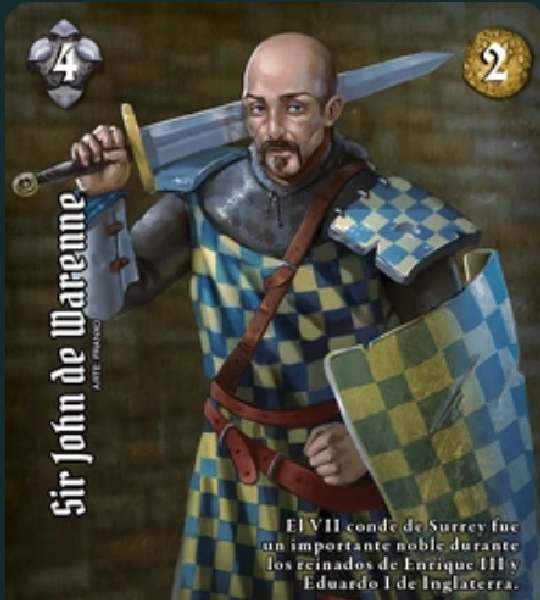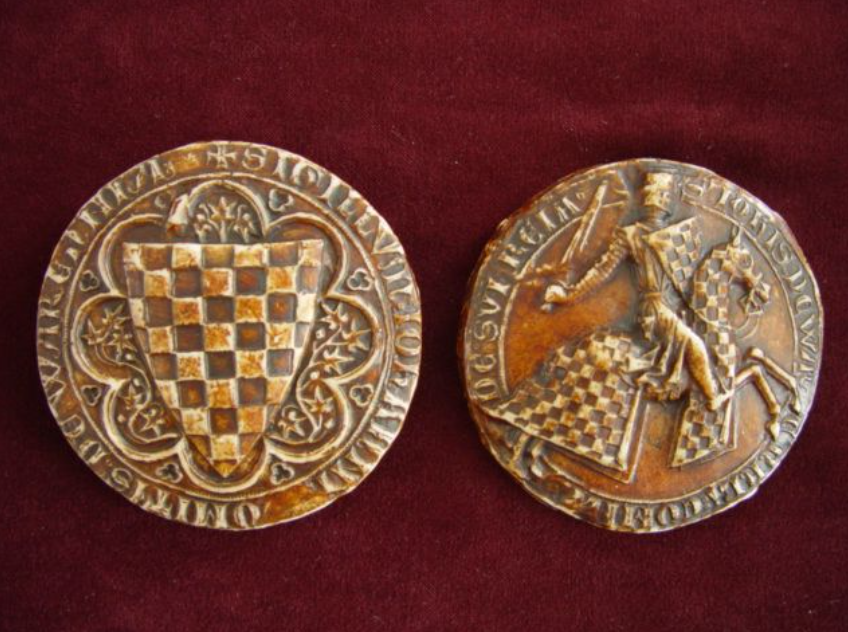There is an interesting story attached to the early days of the House of York. Edward IV wasn’t the first to be accused of being contracted to one woman while pretending to be married to another. And this one too affected the fortunes of the white rose.
Back in the 14th century a similar situation arose for John de Warenne, 7th Earl of Surrey, who lived from June 1286 to June 1347. He was the last of a great Norman family, and was said to have become incredibly rich because of a hoard of treasure guarded by a dragon! Believe it if you wish, but perhaps the truth was that Warenne just had sticky fingers and money simply came his way! He was certainly dizzyingly rich!
On 25 May 1306, at the age of 19, he was married to Joan of Bar, Countess of Surrey the niece of his second cousin, King Edward II. But the two simply did NOT get on so, unsurprisingly, the marriage was childless.
Soon the unhappy husband lived openly with another woman, Maud de Nerford “….daughter of the former William of Neyrford Knight, deceased, of the diocese of Norwich….” with whom he had a number of illegitimate children.
The lack of a legitimate heir became of concern to Warenne and he tried to bring a suit to end his marriage to Joan (or perhaps it would be more correct to seek an annulment) because when they married he had no idea they were related. Really? Hardly believable. He also said he was underage at the time and was forced in it. Ahem, he was 19, well of an age to successfully wriggle out of any prospective match. At the same time Maud petitioned that the marriage of Warenne and Joan should be annulled because she, Maud, had been contracted to Warenne first. It all dragged on until 1316, when the king granted Warenne and Maud permission for their suits to proceed. The outcome isn’t known for certain, but it’s believed they failed and Warenne remained married to Joan of Bar.
Well, by 1320 things had gone wrong between Warenne and Maud, and they parted. Whether or not this was mutual—or because he’d found another love—isn’t known to me, but I suspect the latter. The new love was Isabel Holand, sister of Thomas Holand, 1st Earl of Kent. Yes, the one who married Joan of Kent and caused the scandal that dragged on to affect Joan’s second marriage to the Black Prince…and thus the legitimacy of King Richard II.
It seems the Holands were apt to cause love scandals. Joan’s younger son by Thomas Holand caused two! He seduced the Countess of Cambridge, wife of King Edward III’s son Edmund of Langley, and then he seduced (and had to marry) Elizabeth of Lancaster, daughter of John of Gaunt. Evidently one Holand motto was “Aim high!”
In 1316 Warenne had settled lands [specified as north of the Trent] on Maud de Nerford for her lifetime, with remainder to her three sons by him and their heirs male. In the event of all failing, then the estates etc. would go to the Crown.
But it seems that Warenne had found his true love in Isabel Holand, for they lived openly together as if she was his wife. This was much more than ever had been the case with Maud de Nerford. But they were childless. By then Warenne must have despaired of ever fathering a legitimate heir, and he desperately wanted to produce one with Isabel. On 23 June 1347, when he was 60 and close to death, he made a new settlement in which he recognised Isabel as his wife. (Um, his actual wife, Joan of Bar, was still alive and wouldn’t pass away until 1361. Oh, the echoes of Edward IV!) In the book The Lancashire Hollands by Bernard Henry Holland, Dugdale‘s account of this new settlement is quoted:-
“….If God should please to send him an heir by Isabel de Holland, then his wife, should this heir be male or female, it should be joined in marriage to some one of the blood royal unto whom the King should think fittest, do that the whole inheritance of the Earl with the name and arms of Warenne should be preserved by the blood royal in the blood of the said Earl. If he had no issue from the said Isabel, then his castles and lands should, after his death, remain to the King to be bestowed on one of his own sons on condition that the name, honour and arms of Warenne should be forever maintained and kept….” Again the lands were specified as north of the Trent. The lands south of the Trent would eventually go to Warenne’s nephew, Richard Fitzalan, Earl of Arundel.
Well, Maud de Nerford had passed away before Warenne, and anyway this new settlement replaced the one of 1316, so the Warenne inheritance went to the Crown. King Edward III wasted no time! Within a few days of Warenne’s demise he made an appointment by Letters Patent of these possessions in favour of his youngest-but-one son, Edmund of Langley—whose eventual first wife (as Countess of Cambridge) would be scandalously seduced by Isabel Holand’s nephew! What a tangled web.
It says in The Lancashire Hollands that Edmund of Langley was then six years old, so that when he afterward became Duke of York this large share of the Warenne inheritance was the foundation of the wealth and power of the House of York, especially in Yorkshire, and so is of some importance in English history.
Indeed, and (probably) all because John de Warenne and Joan of Bar couldn’t stand the sight of each other. If they’d gritted their highborn teeth and got on with the necessary bonking, all the above might never have happened. And who knows what lands Edmund of Langley might eventually have been able to pass on to his descendants.
As a footnote, and adding to the tangled web of Holand goings-on, when Edmund of Langley’s first wife died he was married again to one Joan Holland, who was Isabel Holand’s niece and aunt of the Holand who had seduced Edmund’s first wife! Well, they do say keep it in the family.
You can read an excellent and detailed article about it all here.





Phew! Even more tangled than all our Richards and Edwards and Henrys in the Wars of the Roses!
LikeLiked by 1 person
And no sense of humour among them, or there’d be a few rabbits on badges! 😄
LikeLiked by 1 person